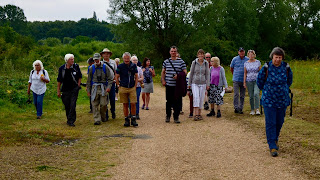I think a lot of us have had bad experiences with guided walks, both as a customer and as a leader. The very worst I have been on was led by a student in a French Chateau, after an hour we tried running away but she caught us up! The worst I have had as a provider was in Scotland when I was supposed to be training some club leaders in how to give a good guided walk. I thought it would be fun to start by doing all the bad things and ask them to tell me what they were. I set off with no introductions and just started walking, leaving half of them behind, then spoke too fast, mumbled with my back to the group, made up facts and got us lost. It was supposed to be hilarious but the group missed the point and some of them were quite cross!
This week-end I led two very pleasant walks around Paxton Pits and I really enjoyed myself. Perhaps it is wrong to say that I led the walks and more correct to say that I played host to two local groups. In both cases we all joined in the search for insects and plants and then helped each other identify them.
 |
| Small skipper. |
On Friday night I hosted a walk for Huntingdon History Festival and on Saturday morning our guests came on a similar walk, organised by the local Wildlife Trust. In both cases we agreed to avoid the main Heron Trail, which is best known for its bird-life, and concentrate on the life to be found in the Meadow Trail where the hay had just been cut and gathered into bales.
 |
| Ringlet. |
I was hoping that we would find some wasp spiders and squadrons of dragonflies but the weather had turned cool and, though insect life was abundant among the herbs and brambles, it was too cold for most of them to be on the move. The good thing about that was that we all had a good chance to look at gatekeepers, ringlets, small skippers and hover flies before they woke up to our presence.


